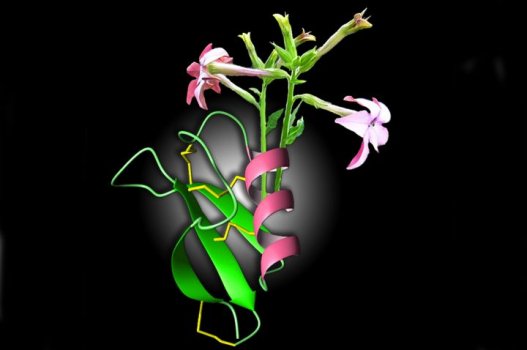3 April 2014
A small peptide molecule that ornamental tobacco plants use to fight off fungal and bacterial infections has the potential to treat cancer in humans, according to a new discovery by Australian researchers.
Called NaD1, the peptide molecule is found in the flowers of an ornamental tobacco plant, Nicotiana alata. When used against cancer cells, it forms a pincer-like structure that grips onto lipids present in the membrane of a fungal cell or a cancer cell and rips the membrane open, causing the cell to expel its contents and explode.

Image caption: The flower of the ornamental tobacco plant and the structure of the molecule NaD1, which scientists say has the potential to treat cancer in humans. Image: Fung Lay, La Trobe University
NaD1 is a ‘host defence peptide’. Peptides are a bit like very small proteins, consisting of a series of amino acids joined together in the same way as in a protein. Host defence peptides typically contain less than 100 amino acids.
La Trobe University researchers led by Marc Kvansakul and Mark Hulett used x-ray diffraction techniques at the Australian Synchrotron’s MX beamlines to determine the structure of NaD1 in the act of binding to a lipid molecule found in the cell membranes of fungi and mammals.
The synchrotron results showed how 14 of the NaD1 molecules work together to surround each lipid molecule and disrupt the cell membrane, ultimately killing the target cell.
The findings were published in a new ‘open access’ life sciences journal called eLife.
Article in The Age newspaper 2 April 2014
